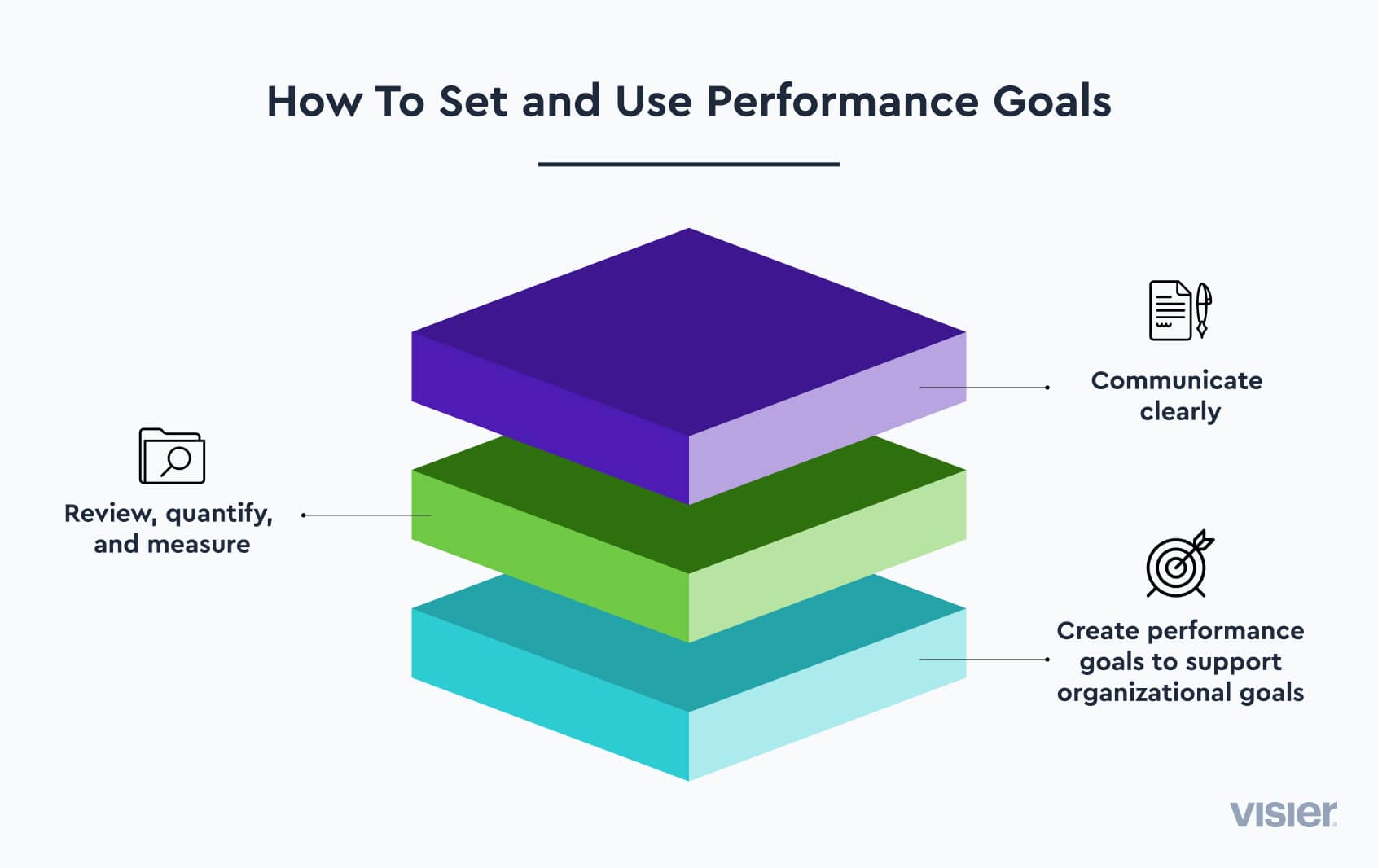MANAGER EFFECTIVENESS
How To Set and Use Performance Goals
Companies use performance goals to communicate expectations, objectively measure success, and reward achievements. Learn about how to use them here.
Take a tour
Table of contents
What are performance goals?What are the benefits, and pros and cons of performance goals?How should you establish and use performance goals?What are some examples of effective performance goals?Ensure that performance goals are driving real impact with people analyticsWhat are performance goals?
Performance goals are short- and long-term targets and milestones that employees are expected to meet during a defined time period. They can be used at all levels of the organization, and are an effective tool for defining expectations and measuring success for individual employees. Performance goals can be tied to specific quotas, achievements, and KPIs, and based on professional development milestones.
However they’re used, performance goals should include the following characteristics.
Specific and measurable
Performance goals are specific, and measurable, objectives used to motivate employees, establish business targets, and track performance.
Performance goals can (and often are) linked to specific achievements.. For example, a sales representative may have a performance goal of generating a certain amount of revenue per quarter.
Goal alignment
But performance goals don’t necessarily need to be tied to individual achievements.. Many organizations set goals for workplace teams or even the entire organization.
For example, the team on which the sales rep from the previous example works may have a group revenue goal in addition to individual goals. The organization as a whole may have larger goals, including the entire sales function, or more complex goals that involve not just sales, but also operations and marketing.
Productivity goals
Productivity is an important measure of performance. Once companies have an idea of what drives the productivity of a role, they can put parameters in place to see how quickly new hires achieve full capacity and to measure the productivity of other employees and teams over time.
Tied to merit increases
Performance goals are often tied to merit increases to ensure that employees are being rewarded for actions related to important organizational metrics.
These goals may cascade from the top to the bottom of the organization, and across functional departments, all designed to ensure that staff are working together to achieve company objectives. This alignment is important from that standpoint and also to provide employees with a line of sight into how their individual performance positively impacts company outcomes.

What are the benefits, and pros and cons of performance goals?
Performance goals are incredibly popular. They can be found in all kinds of organizations, and for good reason. Performance reviews are a great way to tie employee motivation to meaningful corporate objectives.
Here are some of the key benefits of performance goals.
Performance goals provide direction
Without direction, employees may drift into working toward their own personal objectives, generally with the best of intentions. In some cases, though, employees are motivated simply to do as little as possible to earn a paycheck. The term quiet quitting has recently been applied to these types of situations.
Others may be motivated to be protective of their own area of authority, to the detriment of the organization as a whole. Finally, some very well-meaning employees and managers may simply not understand or even be aware of certain company goals.
Tying performance to measurable goals
Performance goals help address this by tying employee performance to specific and measurable goals. This points to another pro of performance goals: they can be designed to be specific and measurable. Instead of a manager telling staff they want to see better customer service, they can set performance goals like hitting a certain threshold on customer satisfaction surveys, for instance.
By doing so, employees are given specific guidance on what they need to do, and what success ultimately looks like.
Team goals to drive collaborative performance
Team- and company-wide performance goals can also be used to build staff cooperation and coordination. For example, a goal to increase profitability can be achieved by increasing revenue, cutting costs or both. This might mean collaboration between cost centers and revenue centers to achieve that goal.
Cons of performance goals
The biggest cons of performance goals are not inherent in the concept of performance goals itself, but rather in how easy it is to use them incorrectly.
For example, a performance goal aimed at boosting sales might incentivize a sales rep to make as many small-value sales as possible to hit their quota, instead of focusing on more profitable, larger deals. Similarly, a goal to reduce production errors could lead to skyrocketing production costs and reduced efficiency.
It’s important, therefore, to be very clear and deliberate with the intent behind performance goals, and to understand how certain goals and incentivization might impact other areas of the business.

How should you establish and use performance goals?
Once an organization determines it can benefit from performance goals, it’s time to think about how to implement them in practice.
Here are some key steps to establishing and using performance goals at your organization.
Start with organizational goals
The first step in this process is to create a list of the top organizational goals and challenges. This could be boosting brand awareness, reducing product returns, or increasing customer service.
Create performance goals to support organizational goals
Once the relevant company objectives have been established, the next step is to create performance goals that support those objectives. This is the tricky part that, if not handled properly, can lead to misaligned incentives, as discussed previously. Good performance goals are closely related to company objectives and avoid creating counterproductive incentives.
Review and quantify
Once performance goals are created, they need to be reviewed and appropriately quantified.
A performance goal for a project manager, for instance, might be to complete a certain percentage of projects in under a certain amount of time. This would support a broader company objective of efficiency.
But what percentage of projects and what time period should be used? This will depend on the specifics of the employee, team, or organization as well as the task at hand. Goals should be aspirational so that employees need to work hard to achieve them but not so challenging that employees get discouraged and give up.
Communicate, communicate, communicate
Finally, goals need to be communicated to employees. This should be done with enough lead time to allow employees to plan for and achieve their goals. And if any compensation is tied to those goals, the impact on pay needs to be crystal clear.

What are some examples of effective performance goals?
We’ve discussed a few examples of performance goals already. But there are plenty of examples available.
Quantifiable performance goals
An accounts receivable department could be given a performance goal to reduce the total value of overdue invoices by 20%. A shipping department might be given a goal to reduce fuel use by 10%. Or a CEO might be given a performance goal of boosting company stock price by 5%.
Really any part of an employee’s, team’s or organization’s job that can be quantified can be translated into a performance goal.
Performance goals to boost individual skills
Koreen Pagano, head of product at Degreed has successfully identified, captured, and measured skills data to help ensure that employees’ skills are continually improving and that they are aligned with company goals. “Skill progression is one of the most important metrics [leaders] can focus on,” she says—alignment helps employees understand their organizational impact.
Company-wide performance goals
Effective performance goals, as we’ve seen, are designed to drive desired organizational performance. Here’s one great example.
A consulting firm identified that its performance was well below the industry average for organizational efficiency and decided to take action. Tracking various “organizational health metrics” they were able to identify areas of opportunity for improvement, put goals in place, and begin measuring progress on a regular basis. Through the effective use of data and careful goal alignment across the organization, the firm was able to improve performance while also reducing its management population.
Ensure that performance goals are driving real impact with people analytics
Performance goals are useful tools to quantify and measure the achievement of core objectives tied to the company’s broader strategy and recipe for success. Without some way to define and measure performance goals, companies will struggle to achieve those goals and can drift aimlessly, reacting to challenges as they emerge instead of proactively seeking to avoid obstacles and identify and capitalize on potential business opportunities.
Unfortunately, many organizations lack the insights and data about their own workforce to create and communicate relevant performance goals down the chain of command. And worse, they lack insight into how the performance goals they do assign impact performance and results for the company. People analytics tools are one way to make that possible.
Strategic compensation tools, for example, allow employers to evaluate and manage employee compensation based on a variety of data inputs, including that person’s success rate for achieving assigned performance goals. By doing so, these platforms can provide visibility into how overall compensation is distributed among low- medium- and high-performers. This helps to ensure that companies are rewarding the right employees, at the right time, based on their achievements versus their performance goals.
Another important area of focus for businesses is understanding how various factors may impact performance goal attainment. If, for example, performance goals are regularly being missed, people analytics tools can help to identify underlying signals. Is there low engagement? Low employee satisfaction? All of this might be an indication that a retention problem is on the horizon. By identifying this risk early, organizations can take steps to right the shift and work toward positive performance goal attainment.
Fair distribution of opportunity is another key priority for performance goals. Diversity takes center stage here. Companies need to be able to objectively evaluate their diversity metrics to ensure that their existing workforce is diverse and equitable, that their hiring practices are inline with diversity goals, and that they are giving equal opportunity to all employees. People analytics can help with this by surfacing that data and providing objective direction.



